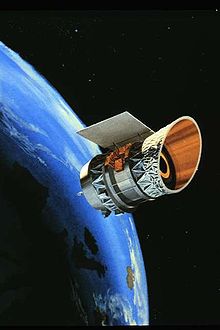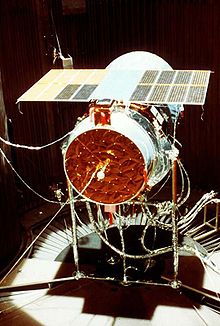- Infrared Astronomical Satellite
-
Der Infrared Astronomical Satellite (IRAS) (Niederländisch: Infra-Rood Astronomische Satelliet) war das erste Weltraumteleskop für das mittlere und ferne Infrarot. Mit seiner Hilfe wurde der IRAS Catalog of Point Sources, Version 2.0 erstellt.[1]
IRAS wurde gemeinsam von den USA, Großbritannien und den Niederlanden entwickelt. Das IRAS-Teleskop mit einem Hauptspiegeldurchmesser von 60 cm war zur Unterdrückung seiner eigenen Wärmestrahlung mit flüssigem Helium als Kühlmittel auf eine Temperatur von 2 bis 5 Kelvin gekühlt. IRAS wurde am 25. Januar 1983 gestartet und war bis zur Erschöpfung des Kühlmittels am 23. November 1983 in Betrieb. Als Weltraumobservatorium oberhalb der Erdatmosphäre konnte IRAS Himmelsobjekte auch bei Wellenlängen beobachten, die vom Erdboden aus durch die Absorption der Atmosphäre nicht nutzbar sind. IRAS war in einer niedrigen sonnensynchronen Erdumlaufbahn, in der der Satellit zur Abschirmung störender Wärmestrahlung ständig die Rückseite der Erde und einen Sonnenschild der Sonne zuwenden konnte.
Hauptinstrument war eine Anordnung aus 62 Infrarotdetektoren ('Survey Array') mit der eine fast vollständige (96 %) Durchmusterung des Himmels bei Wellenlängen von 12, 25, 60 und 100 µm mit einer Winkelauflösung von einigen Bogenminuten gewonnen wurde. Dazu wurde das Teleskop in gleichmäßiger Bewegung entlang langer Streifen über den Himmel geführt. Weitere Instrumente waren ein niedrig auflösendes Infrarotspektrometer für Wellenlängen von 8 bis 23 µm ('Low Resolution Spectrometer' LRS), mit dem etwa 5000 Spektren gewonnen wurden, sowie ein Photometer für die Wellenlängen 50 und 100 µm ('Chopped Photometric Channel' CPC).
Inhaltsverzeichnis
Ergebnisse
Die IRAS-Mission war ein wichtiger Meilenstein der Infrarotastronomie. Die Himmelsdurchmusterung und der daraus gewonnene Katalog von über 300000 Quellen sind noch zwanzig Jahre später wichtige Hilfsmittel der Astronomie. Zu den wichtigsten Entdeckungen gehören:
- Kometen und die von ihnen hinterlassenen Staubstreifen
- Staubscheiben um nahe Sterne wie z. B. Wega
- Junge Sterne, die noch in die Gas- und Staubwolken eingebettet sind aus denen sie entstanden sind
- Die filamentartige 'Cirrus'-Struktur kalten Staubs im interstellaren Medium der Milchstraße
- Galaxien, die ihre durch viele junge Sterne erzeugte hohe Leuchtkraft fast ausschließlich im fernen Infrarot abstrahlen
Siehe auch
Weblinks
- Introduction to IRAS (englisch)
Quellen
- ↑ Detailed Description of II/125. In: VizieR. Centre de Données astronomiques de Strasbourg, 29 Januar 1994, abgerufen am 27. Juli 2008 (englisch).
Wikimedia Foundation.


